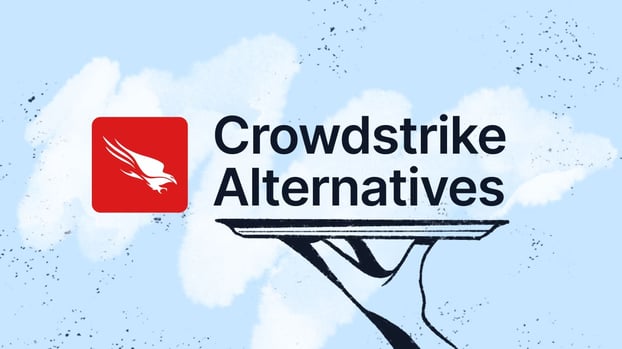Choosing the best endpoint security solution can feel overwhelming with so many options available. Whether you're considering CrowdStrike or exploring its competitors, it's important to understand what features make these solutions stand out.
In this article, we'll break down key aspects of Endpoint Management to help you make an informed decision. We'll cover everything you need to know to select the right protection for your organization.
What is CrowdStrike?
CrowdStrike is a leading cybersecurity company known for its cloud-based endpoint security solutions, primarily through its flagship product, the CrowdStrike Falcon platform. This platform provides comprehensive protection against various cyber attacks, including malware, ransomware, and phishing attacks.
It operates as a cloud-native solution, enhancing threat visibility and enabling real-time monitoring to help organizations identify and mitigate vulnerabilities effectively. Despite its strengths, CrowdStrike has some limitations, such as high costs, complexity in setup, and potential integration challenges with existing systems.

Why do you need to find a CrowdStrike alternative?
Organizations may consider alternatives to CrowdStrike for several reasons:
-
Cost: CrowdStrike's subscription-based model can be expensive, especially for small to medium-sized businesses.
-
Complexity: The platform's advanced features may be overwhelming for teams lacking prior security expertise.
-
Limited OS compatibility: Some features may not be fully supported on non-Windows platforms, which can be a drawback for organizations with diverse operating systems.
-
Integration issues: Integrating CrowdStrike with other security tools can be complex and resource-intensive.
- Its recent update flaw: CrowdStreak has been behind the global Windows crash that has caused operational problems for banks, airports and airlines.
Top competitors of CrowdStrike
Teramind
Teramind is a comprehensive employee monitoring and data loss prevention (DLP) solution designed to help organizations safeguard sensitive information while enhancing productivity. It is particularly valuable for businesses that must comply with strict regulatory standards and mitigate insider threats.
Advanced threat intelligence
-
Monitors user activity and detects insider threats
-
Provides features for analyzing employee productivity and optimizing workflows.
Real-time monitoring
-
Monitors user activity across applications, websites, files, emails, and networks.
Data Loss Prevention (DLP)
-
Monitors and controls the transfer of sensitive information, ensuring that data remains secure even during file transfers or modifications.
User behavior analysis
-
Analyzes user behavior to detect and respond to threats.
SentinelOne Singularity Platform
SentinelOne is an AI-driven cybersecurity platform that provides endpoint protection, threat detection, and automated response capabilities. Its unique selling point is its ability to operate autonomously, allowing it to detect and respond to threats in real-time with minimal human intervention.
Autonomous endpoint protection
-
Unified Nextgen Antivirus (NGAV), EPP, EDR, and XDR solution with AI automation capabilities.
-
Detects advanced threats and provides incident response capabilities to SecOps teams.
AI-powered threat detection
-
Uses AI-powered threat detection and response to protect endpoints, Cloud, and Identity on Active Directory services.
Real-time response
Provides real-time threat detection and response capabilities.
Cynet 360
Cynet 360 is an all-in-one cybersecurity solution that integrates Endpoint Protection Platform (EPP), Next-Generation Antivirus (NGAV), Endpoint Detection and Response (EDR), and automated incident response capabilities. Its comprehensive approach makes it a strong contender for organizations looking to streamline their security operations without the need for multiple disparate tools.
Unified security model
-
A cohesive security framework that encompasses endpoint protection, network analytics, user and entity behavior analytics (UEBA), and deception technology.
Advanced threat detection
-
Signature-based and behavioral detection methods to identify both known and unknown threats.
Automated incident response
-
Automated response capabilities to quickly contain and remediate threats without extensive manual intervention.
VMware Carbon Black
VMware Carbon Black is a cloud-native endpoint protection platform that offers advanced threat detection and response capabilities. It is designed for organizations that require robust security measures to protect their endpoints from sophisticated threats.
Next-generation endpoint protection
-
Combines traditional antivirus functionalities with advanced threat detection capabilities, including behavioral analysis and machine learning.
Threat hunting and investigation
-
Extensive threat-hunting tools for security teams to search for indicators of compromise (IoCs) across their environments.
Other features
-
Behavioral analytics to identify and respond to threats.
-
Real-time visibility into endpoint activity.
-
Integration with existing VMware infrastructure.
Sophos Intercept X
Sophos Intercept X is an advanced endpoint protection solution that combines EDR, XDR, and Managed Threat Response (MTR) capabilities. It is designed to provide proactive protection against a wide range of cyber threats, including ransomware and advanced persistent threats.
Prevention-first Approach
-
Deep learning technology enhances the detection of both known and unknown malware, as well as exploits prevention capabilities to block sophisticated attack techniques.
Managed Threat Response (MTR)
-
Fully managed threat detection and response service that provides 24/7 monitoring and incident response by security experts.
Other alternatives
-
Darktrace
-
Utilizes AI to detect and respond to threats autonomously, focusing on self-learning capabilities to adapt to new threats.
-
-
Symantec Endpoint Security Complete
-
Provides complete protection for traditional and mobile devices. Includes behavioral isolation, Active Directory security, and Threat Hunter technologies.
-
-
ESET Protect
-
It provides a user-friendly interface and strong endpoint protection capabilities, which is ideal for organizations with limited IT resources.
-
-
Cortex XDR By Palo Alto Networks
-
Blocks advanced malware, exploits, and file-less attacks. Offers network security and threat detection capabilities.
-
-
Fortinet
-
Delivers a range of cybersecurity solutions, including endpoint protection and network security, with a focus on integrated threat intelligence.
-
-
Webroot Business Endpoint Protection
-
A lightweight and easy-to-manage solution particularly appealing to small and medium-sized businesses.
-
-
Cisco Secure Endpoint
-
Combines endpoint protection with network security, providing a comprehensive security solution for enterprises.
-
-
Trellix Endpoint Detection and Response (EDR)
-
Focuses on threat detection and response, offering advanced capabilities for identifying and mitigating threats.
-

Key features to consider to evaluate endpoint security solutions
We highlighted some security features for the different top Crowdstrike competitors. Let's explore some of those features and their benefits in more detail:
Security features
1. Threat intelligence: detection and response
Real-time monitoring is critical for effective endpoint security. This involves continuously observing endpoints to detect threats such as malware, ransomware, and other intrusions as they occur. Real-time monitoring ensures that any malicious activity is identified immediately, allowing for swift action to prevent potential damage.
In addition, automated response capabilities are essential. These enable the security solution to contain and remediate threats without needing extensive manual intervention, thereby minimizing the impact of security incidents and reducing the workload on IT security teams.
2. Behavioral analysis
User and entity behavior analytics (UEBA) leverages machine learning to analyze the behavior of users and entities within the network. By understanding normal behavior patterns, the system can identify anomalies that may indicate a potential threat, such as unusual login times or data access patterns. This proactive approach helps detect breaches before they cause significant harm.

3. Prevention capabilities
Next-generation antivirus (NGAV) solutions go beyond traditional signature-based detection methods. They use advanced techniques such as machine learning and behavior analysis to block malware and other threats before they can execute. This includes preventing exploits and protecting against zero-day vulnerabilities, which are particularly dangerous because they exploit unknown flaws.
4. Data loss prevention (DLP)
Data loss prevention features are designed to prevent unauthorized access to sensitive data, thereby mitigating the risks associated with insider threats. This involves monitoring data transfers, blocking unauthorized file sharing, and ensuring that sensitive information does not leave the organization's network without proper authorization.
5. Sandboxing
Sandboxing provides an isolated environment where suspicious files can be executed and analyzed without risking the production environment. This is crucial for identifying and mitigating unknown emerging threats, as it allows security teams to observe the behavior of potentially malicious files in a safe setting.
6. Endpoint device tracking
Managing lost or stolen devices is a critical aspect of endpoint security. Device tracking capabilities allow organizations to locate and manage these devices remotely. Features such as remote wiping help protect sensitive data from being accessed by unauthorized individuals in the event of a device being lost or stolen.
7. Compliance Management
Supporting compliance with industry regulations is a critical feature. This involves enforcing Compliance Management security policies across all endpoints, maintaining logs, and generating reports for audits. Ensuring compliance helps organizations avoid legal penalties and maintain their reputation.

Other features to consider:
1. Centralized management dashboard
A unified management console simplifies the monitoring and management of endpoints. An intuitive interface enables security teams to quickly assess the overall security posture and respond to incidents effectively. This ease of use is crucial for maintaining a high level of security without overwhelming the IT staff.
2. Integration capabilities
Endpoint security solutions should be compatible with existing security infrastructure, such as firewalls, intrusion detection systems, and SIEM solutions. Integration with these tools enhances overall security effectiveness by streamlining operations and providing a more comprehensive defense strategy.
3. Flexible deployment options
Organizations need to consider whether they prefer cloud-based solutions for scalability and ease of management or on-premises solutions for greater control over data and compliance. The choice depends on the specific needs and constraints of the organization, such as regulatory requirements and available resources.
4. Cost-effectiveness
Evaluating the total cost of ownership is essential to ensure that the chosen solution fits within the organization's budget. This includes considering licensing fees, implementation costs, and ongoing maintenance expenses. A cost-effective solution provides robust security without straining financial resources.
Final words
In conclusion, while CrowdStrike remains a dominant player in the endpoint security market, organizations must consider various alternatives that may better suit their specific needs and budgets.
Cybersecurity threats continue to evolve, and organizations aiming to protect their digital assets effectively should look for the best software to support them. Take the time to evaluate your options and choose a solution that offers the best combination of protection, ease of use, and cost-effectiveness.















